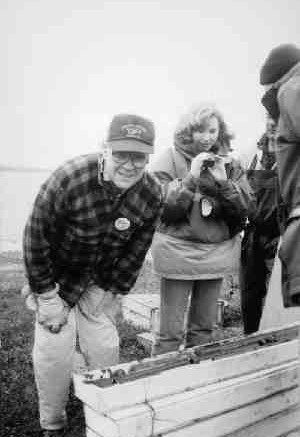Construction of the Diavik diamond mine is nearly one-third finished, with startup slated for April 2003.
When all is said and done, London-based
The project is centred on four kimberlite pipes immediately offshore of the 20-sq.-km East Island in Lac de Gras, 300 km northeast of Yellowknife and 30 km southeast of the producing Ekati diamond mine. Diavik Diamond Mines, a wholly owned division of Rio Tinto, is the operator and 60%-owner of the joint-venture project. Aber owns the remaining 40%.
An independent feasibility study, prepared by SNC Lavalin in May 2000, defined proven and probable reserves of 25.7 million tonnes grading 4.2 carats per tonne, equivalent to 106.7 million carats at a value of US$65 per carat. The total resource of the four pipes is estimated to a depth of 420 metres at 37.4 million tonnes grading 3.7 carats per tonne, or 138 million carats.
More than half of the minable reserve is contained in the A-154 South pipe, estimated at 11.7 million tonnes grading 5.2 carats per tonne at US$79 per carat, which equates to US$412 per tonne of kimberlite.
Site operating costs are forecast to average US$89 per tonne during the first 10 years and US$101 per tonne for the life of the mine. These operating-cost estimates do not include sorting, valuation, marketing, royalties and reclamation.
The joint venture provides for each partner to market its own share of diamond production. In July 1999, Aber struck a deal with upscale jeweller
The mine development plan calls for the construction of a series of water retention dykes to permit open-pit mining of the four pipes in three separate pits. As the pits deepen, mining will shift underground on the A-154 South and A-418 pipes.
On East Island, a kimberlite process plant is being built with an annual design capacity of 1.9 million tonnes. The plant will treat ore at an annual rate of between 1.5 and 1.8 million tonnes using conventional diamond recovery technology.
Production for the first 10 years will come from the A-154 pit, which will incorporate both the A-154 South and A-154 North pipes (1.3 million tonnes of minable reserves grading 3.5 carats per tonne at US$33 per carat). Production from the A-418 pipe (8.7 million tonnes grading 3.4 carats per tonne at US$56 per carat) will begin in 2010 and continue to 2022. Pipe A-21 (4 million tonnes grading 3 carats per tonne at US$28 per carat) will be mined from 2013 to 2019. Underground production from A-154 South is scheduled for 2015-2019.
Dredge
It will take nearly 6 million tonnes of rock placed along a 6-km-long path to build the first dyke around the two 154 pipes, which are separated by only 100 metres. A barge-mounted dredge is being used to remove the lake bottom sediments so that the dyke can be built on the more stable underlying glacial till. The sediments are being pumped to sedimentation ponds, which were built on the island earlier this year. Floating plastic silt curtains have been deployed around the dyke construction to contain muddy waters and protect the rest of Lac de Gras.
Rockwork for the dyke is scheduled for completion this fall. A 1-metre-thick impervious plastic concrete wall extending through the centre of the dyke to bedrock will prevent lake waters from seeping into the pit. The waterproof barrier will be finished in summer 2002, followed by the de-watering of the pit in preparation for mining.
Grouting along the North Inlet dyke, which forms a small dam as part of the water management system, is continuing, along with foundation and concrete work at the North Inlet water treatment plant.
Concrete work at the process plant and maintenance shop is progressing on schedule. Meanwhile, piling installation and the pouring of the concrete walls for the 264-person permanent housing complex are well under way.
Construction of the internal structural steel columns for the 11-story processing plant, boiler house and power plant is in progress at, and work has begun on the Arctic corridors, which serve as covered walkways to different parts of the complex. A third permanent fuel tank is nearing completion and commissioning of the sewage treatment plant continues.
Aber is arranging the remainder of its financing requirements to fund its 40% share of capital costs. The company has adequate cash to last into the first quarter of 2002.


Be the first to comment on "Global Diamond Diavik project inches toward April 2003 startup"